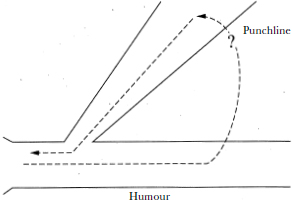
Figure 2.9
EINSTEIN USED TO carry out what he called “thought experiments”. He would say: “What would I see if I were travelling at the speed of light?”
The child who places one block upon another “to see what happens” is carrying out an experiment. Provocation has everything to do with experiments in the mind.
In an earlier section I described how many important new ideas came about through chance, accident, mistake, or “madness”. All these provided a sort of discontinuity, which forced us outside the usual boundaries of “reasonableness” that had been established by our experience. With deliberate provocation we have a systematic method that can produce the same effects. We do not have to wait for change, accident, or mistake. We can be temporarily “mad” for just thirty seconds at a time in a controllable fashion. We can switch the madness on and off as we wish. That is why provocation is such a fundamental aspect of lateral thinking and of creativity in general.
We were considering river pollution.
Po, the factory is downstream of itself.
That is a provocation. It seems utterly impossible. How could the factory be in two places at once? We use the symbolic word “po” to indicate that this is intended as a provocation and not as a serious suggestion (the origin and nature of “po” will be described later).
From this provocation comes a consideration of the input and output of the factory. It would be normal to take in water upstream and put out effluent downstream. The provocation suggests that we might legislate that if a factory is built on a river then the input must be downstream of the output so the factory is the first to sample its own pollution and must therefore be more concerned to minimize effluent pollution. In hindsight this idea is perfectly logical. I am told it has become legislation in some countries.
At DuPont there was some discussion about how to handle a new product. David Tanner put in a provocation.
Po, we sell the product to our competitors.
That provocation led to a change in the normal way of handling such a product, and a huge reduction in development time.
Po, cars should have square wheels
Po, planes should land upside down
Po, letters should be closed after they have been posted
All the above statements seem highly illogical and even “crazy”. In fact, they are perfectly logical statements in the context of a patterning information system.
The definition of a provocation is simple:
With a provocation there may not be a reason for saying something until after it has been said.
This contrasts strongly with our normal thinking habits in which there must be a reason for saying something before that thing is said. With a provocation we make the statement and then the effect of that statement will provide the retro-justification for making the statement.
At first it might seem that provocation is simply a scatter-gun approach in which you say anything that comes to mind in the hope that something might just prove useful. To some extent this is the way brainstorming is used by some people. Such an approach would be weak and very wasteful.
In fact, provocation is a logical necessity in any self-organizing system. Mathematical papers have been written to this effect. Such systems “bed down” into stable states. A provocation introduces instability and allows a new stable state to be reached.
The brain forms asymmetric patterns as shown in the basic Figure 2.9. Humour occurs when we are taken from the main track and deposited at the end of the side-track. From there we can see our way back to the starting point. Creativity occurs in exactly the same way. But how do we get across from the main track to the side-track? This is where the systematic provocation methods of lateral thinking come in.
Figure 2.10 shows how we set up as a provocation a concept or an idea that does not exist in our experience. So this provocation lies outside the patterns of our experience.

Figure 2.9
Figure 2.11 shows how we then “move” from the main track to the provocation and then on to the sidetrack. Once on the side-track we can trace our way back to the starting point and so open up the side-track as a new idea.
There is no magic in the process. In chemistry, if we want to move from one stable compound to another we may first have to move to an unstable compound which then re-stabilizes as the new compound. In physics, the changing of an atomic configuration may go through the same unstable step.
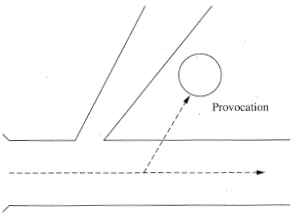
Figure 2.10
In normal thinking, each step that we take is firmly based on the preceding step (vertical thinking). When we arrive at a solution then the validity of that solution is proved by the validity of every step that has taken us from the starting point to the solution. This step-by-justified-step process is illustrated in Figure 2.12.
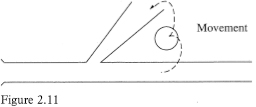
Figure 2.11
In provocation, we move from the starting point to an arbitrary provocation. Then we “move” on from the provocation to an idea or concept. The validity of this result can never be justified by how we got there. But if we can now look back to the starting point (the problem or the area of concern) we may see, in hindsight, how the new position has a real value. If this value can be shown, logically, in hindsight, then the value is just as useful as if it had been achieved through a succession of valid steps. Hindsight justification of an idea is every bit as valid as any other form of justification.
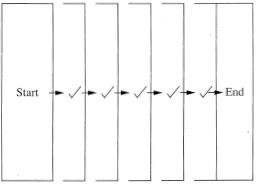
Figure 2.12
But why do we need to use this “jump” method? Why should we have to justify by working backwards? The reason is very simple. In any pattern-forming system we have to take the established pattern forward at any point. So the established or traditional line of thinking takes us forward. There is no choice and we are not even aware of other possibilities.
It is only by working backwards that we are able to open up and use these other tracks – which have been there the whole time. This process is shown in Figure 2.13.
The purpose of the provocation is precisely to get us out of the usual maintrack of thinking. From the provocation we move on to find a new point which in hindsight seems to offer value. It is the escape from the established main track that is so important. The brain has to work to establish the main tracks. That is the very essence of the excellence of the brain. At the same time we need ways of getting out of those main tracks in order to be creative. That is why provocation plays so central a role in lateral thinking.
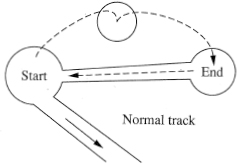
Figure 2.13
I have already mentioned the great value of the “hypothesis” mechanism that allows us to guess at an underlying mechanism. This guess then provides direction and a framework for our thinking about the situation.
A provocation also provides us with a novel framework for looking at things. But a provocation goes much beyond a hypothesis. A hypothesis tries to be reasonable. A provocation usually tries to be “unreasonable” in order to jerk our thinking out of its usual channels.
We seek to reach, justify, and prove a hypothesis, which then moves from being a guess to being a provisional truth. We never seek to reach or justify a provocation. We never seek to prove that square wheels would be useful on a car or that planes should really land upside down. We seek to get to a useful idea that is quite separate and different from the provocation. The provocation is just a way of getting there.
Both hypothesis and provocation seek to change our perceptions. A hypothesis seeks to guide our perceptions in a certain direction. A provocation seeks to take our perceptions away from their usual direction.
Both hypothesis and provocation are speculations that we construct in our minds and then use to improve our thinking about a situation. Both hypothesis and provocation are part of the creative process and are quite different from analysis. Analysis looks at what is there. Provocation and hypothesis both bring in something that is not there.
The formal and deliberate technique of provocation is a two-stage process. The first stage involves the setting up of the provocation. The second stage involves the use of the provocation to move forward to a useful new idea.
Obviously, the first stage precedes the second stage when we come to apply the technique of provocation. The sequence has to be:
In practical terms, however, it makes sense to learn how to use provocations before learning how to set them up. In this way we know how to use provocations when we learn how to set them up. There would not be much point in setting up strange-looking provocations without any sense of how to use them. This general process of learning backwards is very powerful and very logical and is described elsewhere.fn1
Using provocations involves a special mental operation called “movement”. This is an active mental operation. It is also completely different from judgement. Movement is an operation that we have to learn and practise in order to build up skill and fluency.
When we have considered the operation of movement then we can proceed with the methods of setting up provocations.
fn1 Mentioned in the book I am Right You are Wrong published by Viking, New York, 1991 and Penguin Books, London, 1990.